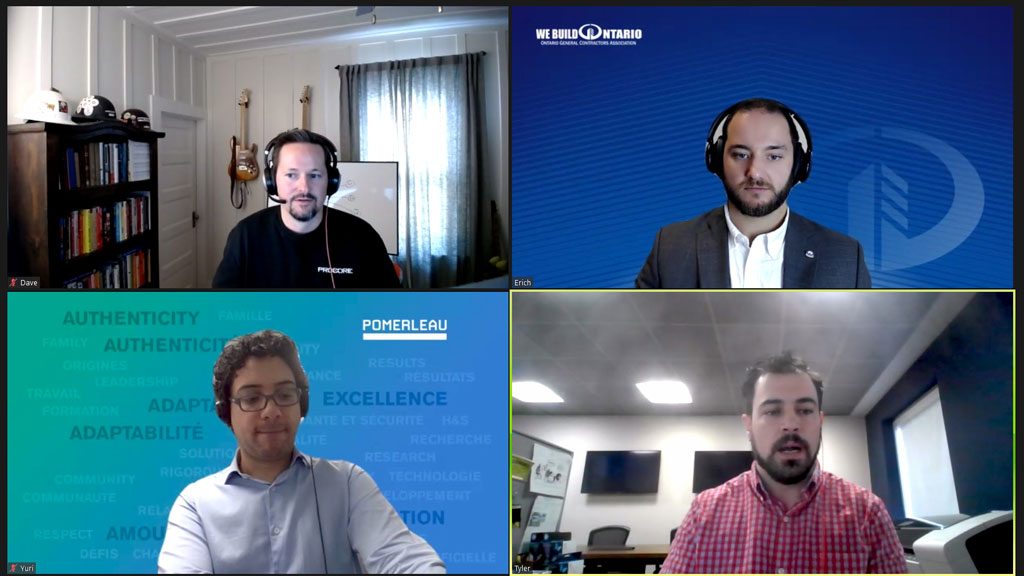BIM offers tremendous opportunities to boost productivity and get jobs done faster and cheaper but only if all parties are committed and there is a clear process to follow.
That was the message delivered by panellists assembled by the Ontario General Contractors Association (OGCA) recently for a webinar billed as Building a BIM Team: How to Harness the Power of Collaborative Technology.
The session served as a follow-up to the OGCA’s recent publication of the OGCA Guide to Construction Design and Technology, which focused on BIM (Building Information Modeling).
“In the end, BIM does cost money to implement,” said panellist Yuri Bartzis, an innovation manager with Pomerleau.
“But if you have a good plan in place and you use those 3D models effectively, guaranteed you’re going to save money throughout your project. That’s making sure that you’re completing your BIM goals, that you have a plan in place, a BIM execution plan that makes sure that all the stakeholders are in line and work towards those common goals that are identified in the BIM execution plan.”
Other panellists were Tyler Holditch, director of technology at Matheson Constructors, and Dave McCool, group product manager at event sponsor Procore. The webinar was hosted by Erich Schmidt, the OGCA’s innovation manager.
Successful BIM teams should have commitment at all levels, from the owner right down to the maintenance team and even the suppliers, Bartzis said. There should be a fundamental understanding of how BIM works and how every step is interdependent.
Everyone should become involved in the BIM model as early as possible. Engineers typically take on the role of BIM manager and are responsible for implementing the execution plan as designed by the architect or general contractor.
Contractors can use BIM models to co-ordinate building systems, detect clashes and communicate those problems with the parties responsible for the errors, Bartzis said. Quantity takeoffs and schedule verification should also be tasks incorporated into the BIM plan.
BIM can also be used to highlight holes in the design or potential issues where construction doesn’t match the design intent, Bartzis added.
“That’s identifying areas of risks throughout the project,” he said. “As a general contractor, we want our construction teams to work as productively as possible, to work without stoppages.”
Time savings result in cost savings, he said.
“A perfect example is with RFI and the entire RFI process,” explained Bartzis. “When you submit an RFI, you’re essentially submitting a question to a designer. If you can detail that question or support that question with a visual, the question becomes that much more clear. You’re reducing the amount of time that the designer will take to understand that question.”
The old adage about a picture being worth a thousand words is very true with BIM, Holditch said, especially when the picture is in 3D and there is information embedded by all participants.
“The second you open a 3D model and you show any kind of content, you get instant engagement from all of these individuals,” he said.
With each person added to a team contributing to the BIM model, the benefits expand beyond the linear additions of a non-BIM project, Holditch said.
“For every additional individual or team player that joins a process, you’re exponentially being valued,” he stated.
A supplier who is connected to a BIM project can work with the contractor, building a library that is accessible to everyone.
“The more people you can get involved, the more value you’re going to get,” said Holditch.
As for facilities management, Holditch said, “Some owners are going to want to be able to take that data model, extract all the information and plug it into the facility management software. So this conversation is happening at the beginning.
“Again, it’s a collaborative effort. You shouldn’t work in silos.”
McCool noted a facilities manager who is plugged into the BIM model will have easy access to where shutoff valves or J hooks are located, for example.
“So if you can work with them, you can optimize the maintenance and operations cost, because it doesn’t take as long to get to those things now, you’re not searching for them,” he said.
Overall, said Bartzis, the high level of collaboration through BIM filters into the success of the project.
“One of the biggest points is that building of trust between all the different stakeholders, and you can feel that each member on the project team is working towards a common goal of building the project and finishing that project on time, on schedule,” he said.
Follow the author on Twitter @DonWall_DCN.











Recent Comments
comments for this post are closed